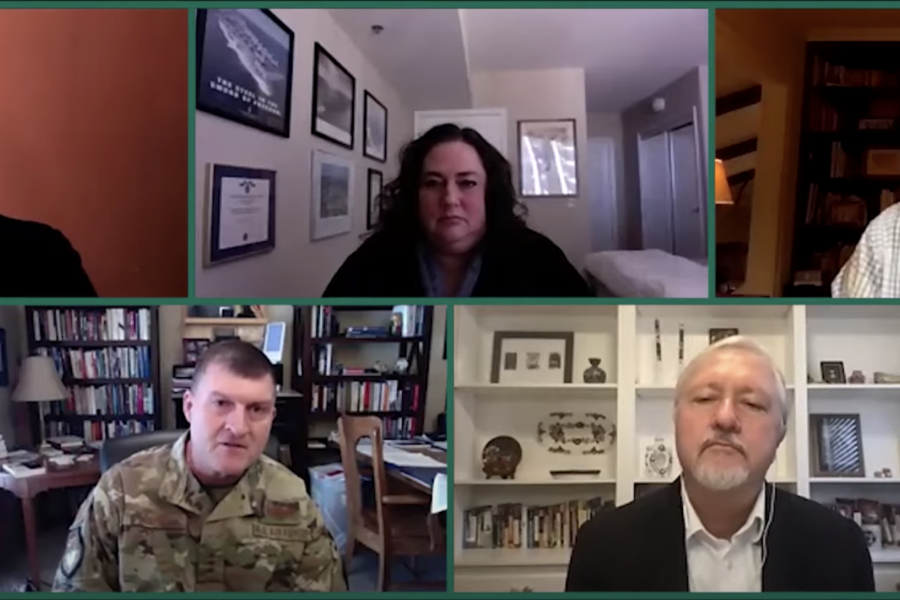As the Air Force pieces together its fiscal 2023 budget, due early next year, it must think not only about the immediate future, but also five years down the road.
That’s a challenge right now, said Lt. Gen. S. Clinton Hinote, the Air Force’s deputy chief of staff for strategy, integration, and requirements.
“I should know what the requirements are in 2027. I don’t,” the planning boss said during a March 5 event hosted by the Hudson Institute.
Broadly, the Air Force knows what it wants: modern, artificially intelligent networking capabilities to connect its people, planes, and data in new ways; faster, stealthier, or longer-range aircraft and weapons; a fresh slate of nuclear weapons; disposable drones.
Hinote’s comfortable with how the Air Force is investing in military-specific technology so far. But it gets murkier when he tries to envision how commercial-sector innovation could bleed into the military realm.
“Cloud computing, artificial intelligence, machine learning—these are all things where there’s a great amount of progress being made in a very short amount of time,” he said. “When I talk to leaders in the tech world, they look at me like I’m crazy when we start to say, ‘What’s going to happen in 2027?’”
It’s tough to put a dollar figure on ideas that could change so drastically in the next half-decade. That lack of clarity can also complicate how the Air Force decides to allocate its money under the “Accelerate Change or Lose” modernization plan.
Later this year, the Air Force will have to pitch an updated funding plan for the Advanced Battle Management System, its piece of the Pentagon’s joint all-domain-command-and-control puzzle. That blueprint will need to work with the ideas submitted by the Army, Navy, Marine Corps, and Space Force so each service’s systems can communicate in combat.
“We know the general requirements, and I think we know the general trajectory of the acquisition program, but what we don’t know is what we’re going to buy in 2027. If I was going to tell you, I can tell you, I’d be 100 percent wrong about that.”
The price tag for the multibillion-dollar ABMS project is still evolving. The Air Force stresses that it’s important to keep an open mind and avoid getting locked into certain technologies to remain flexible over time, while lawmakers have said they want to see more certainty in the program.
Keeping Congress in the loop as the service’s plans for ABMS and more evolve can help avoid programming whiplash, but Hinote said Capitol Hill is dubious about the Air Force’s ability to deliver.
Last week, Hinote said, he presented the findings from a recent set of major wargames to a congressional defense committee’s staff.
“I was talking through some of the new capabilities we played, some of the way that it worked,” he said. “I remember one of the staffers looking up and saying, ‘You know, this all sounds great, but I have no confidence that we can field these capabilities in the timeline you’re talking about.’”
Hinote slumped in his chair. “I said, ‘I share your skepticism on that, but China’s doing it. China’s doing it so rapidly that, literally, they’ll get two or three cycles in to our one if we don’t change something,’” he continued. “They began to realize, ‘Wow, we’re in this together.’”
That echoes recent remarks by Air Combat Command boss Gen. Mark D. Kelly urging the U.S. to move faster on finishing the futuristic fighter capability known as the Next-Generation Air Dominance program, before China gets there first.
The solution to budgeting uncertainty in the military technology race may be to rethink the way the armed forces plan their finances, Hinote said.
In recent years, the Pentagon has advocated for more flexibility in areas like software development, so it can move money around as new updates roll out. Hinote envisions an even more malleable approach.
He called for a more adaptable process that keeps up with the tech sector without skimping on civilian and legislative oversight.
“What we’re hoping to be able to do is harness that power through a flexible-enough budget process that allows us to do that iteration,” he said. “I’m really excited that—maybe—we’re seeing some movement in this direction, even from people who I think have been very skeptical about the idea of flexible budgeting.”
